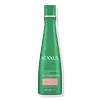What's inside
What's inside
 Key Ingredients
Key Ingredients

No key ingredients
 Benefits
Benefits

 Concerns
Concerns

 Ingredients Side-by-side
Ingredients Side-by-side

Water
Skin ConditioningCocamidopropyl Betaine
CleansingSodium Methyl Cocoyl Taurate
CleansingSodium Chloride
MaskingGlycerin
HumectantSodium Gluconate
Skin ConditioningKeratin
Skin ConditioningHydrolyzed Keratin
HumectantBiotin
AntiseborrhoeicCollagen Amino Acids
MoisturisingArginine Hcl
Skin ConditioningPrunus Armeniaca Kernel Oil
MaskingSpirulina Platensis Extract
Skin ProtectingFucus Vesiculosus Extract
EmollientCitrullus Lanatus Seed Oil
EmollientCitric Acid
BufferingCoconut Acid
CleansingParfum
MaskingSodium Benzoate
MaskingGlycol Distearate
EmollientPPG-9
Skin ConditioningPolyquaternium-10
Stearamidopropyl Dimethylamine
EmulsifyingCitronellol
PerfumingEugenol
PerfumingGeraniol
PerfumingLimonene
PerfumingLinalool
PerfumingWater, Cocamidopropyl Betaine, Sodium Methyl Cocoyl Taurate, Sodium Chloride, Glycerin, Sodium Gluconate, Keratin, Hydrolyzed Keratin, Biotin, Collagen Amino Acids, Arginine Hcl, Prunus Armeniaca Kernel Oil, Spirulina Platensis Extract, Fucus Vesiculosus Extract, Citrullus Lanatus Seed Oil, Citric Acid, Coconut Acid, Parfum, Sodium Benzoate, Glycol Distearate, PPG-9, Polyquaternium-10, Stearamidopropyl Dimethylamine, Citronellol, Eugenol, Geraniol, Limonene, Linalool
Water
Skin ConditioningCetearyl Alcohol
EmollientStearamidopropyl Dimethylamine
EmulsifyingCocos Nucifera Oil
MaskingHydrolyzed Elastin
EmollientSea Salt
AbrasiveHydrolyzed Keratin
HumectantHydrolyzed Wheat Protein
Skin ConditioningPanthenol
Skin ConditioningTocopheryl Acetate
AntioxidantAscorbic Acid
AntioxidantParfum
MaskingBehentrimonium Chloride
PreservativeLactic Acid
BufferingDipropylene Glycol
HumectantPotassium Chloride
Trehalose
HumectantDisodium EDTA
Gluconolactone
Skin ConditioningDMDM Hydantoin
PreservativeAdipic Acid
BufferingSodium Sulfate
Methylchloroisothiazolinone
PreservativeMethylisothiazolinone
PreservativeWater, Cetearyl Alcohol, Stearamidopropyl Dimethylamine, Cocos Nucifera Oil, Hydrolyzed Elastin, Sea Salt, Hydrolyzed Keratin, Hydrolyzed Wheat Protein, Panthenol, Tocopheryl Acetate, Ascorbic Acid, Parfum, Behentrimonium Chloride, Lactic Acid, Dipropylene Glycol, Potassium Chloride, Trehalose, Disodium EDTA, Gluconolactone, DMDM Hydantoin, Adipic Acid, Sodium Sulfate, Methylchloroisothiazolinone, Methylisothiazolinone
Ingredients Explained
These ingredients are found in both products.
Ingredients higher up in an ingredient list are typically present in a larger amount.
Hydrolyzed Keratin is derived from keratin. Keratin is a large protein that is naturally found in our hair and skin.
Studies show keratin is able to seal broken hair cuticles, helping to prevent split ends and breakage.
As a humectant, hydrolyzed keratin helps draw moisture from the air to your hair and skin. This helps keep your skin and hair hydrated.
Learn more about Hydrolyzed KeratinParfum is a catch-all term for an ingredient or more that is used to give a scent to products.
Also called "fragrance", this ingredient can be a blend of hundreds of chemicals or plant oils. This means every product with "fragrance" or "parfum" in the ingredients list is a different mixture.
For instance, Habanolide is a proprietary trade name for a specific aroma chemical. When used as a fragrance ingredient in cosmetics, most aroma chemicals fall under the broad labeling category of “FRAGRANCE” or “PARFUM” according to EU and US regulations.
The term 'parfum' or 'fragrance' is not regulated in many countries. In many cases, it is up to the brand to define this term.
For instance, many brands choose to label themselves as "fragrance-free" because they are not using synthetic fragrances. However, their products may still contain ingredients such as essential oils that are considered a fragrance by INCI standards.
One example is Calendula flower extract. Calendula is an essential oil that still imparts a scent or 'fragrance'.
Depending on the blend, the ingredients in the mixture can cause allergies and sensitivities on the skin. Some ingredients that are known EU allergens include linalool and citronellol.
Parfum can also be used to mask or cover an unpleasant scent.
The bottom line is: not all fragrances/parfum/ingredients are created equally. If you are worried about fragrances, we recommend taking a closer look at an ingredient. And of course, we always recommend speaking with a professional.
Learn more about ParfumWe don't have a description for Stearamidopropyl Dimethylamine yet.
Water. It's the most common cosmetic ingredient of all. You'll usually see it at the top of ingredient lists, meaning that it makes up the largest part of the product.
So why is it so popular? Water most often acts as a solvent - this means that it helps dissolve other ingredients into the formulation.
You'll also recognize water as that liquid we all need to stay alive. If you see this, drink a glass of water. Stay hydrated!
Learn more about Water